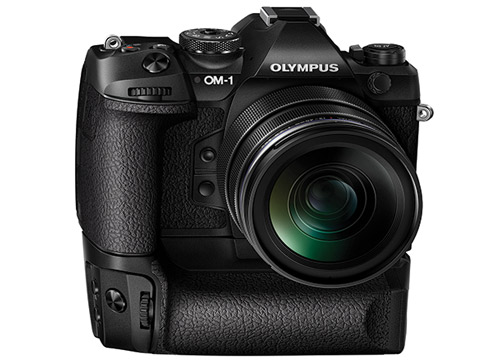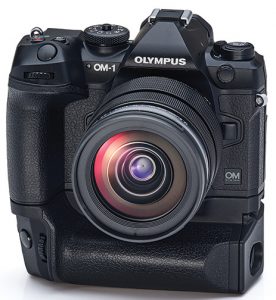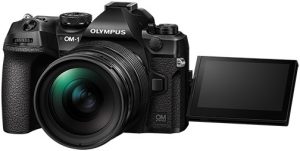
Bethlehem, PA—OM Digital Solutions introduced the OM System OM-1 Micro Four Thirds interchangeable-lens camera. The new flagship ILC features a compact, lightweight design for mobility, along with high image quality.
“As the OM System flagship camera, this model will deliver a one-of-a-kind experience to customers, driving the desire for photographers to create,” the company announced. “This interchangeable lens camera delivers inspiration in a lightweight design that users can take along anywhere to capture the precise photos they have in mind.”

In addition, OM Digital Solutions debuted two MFT pro-aimed lenses. The M.Zuiko Digital ED 12–40mm f/2.8 Pro II (24–80mm equivalent) is a standard zoom lens with a brightness of f/2.8 across its zoom range. What’s more, the new M.Zuiko Digital ED 40–150mm f/4.0 Pro (80–300mm equivalent) is billed as “the world’s most compact, lightweight model featuring a fixed maximum aperture value of f/4.0.”
Key OM System OM-1 Features
The compact, lightweight OM-1 employs a new 20-megapixel stacked BSI (backside-illuminated) Live MOS sensor. It’s paired with the latest TruePic X image processor, which is three times faster than previous models. Not only does the ILC take full advantage of high-resolution M.Zuiko Digital lens performance, it also uses new noise processing technology. Thus, its normal sensitivity of ISO 25,600 expands to a maximum of ISO 102,400. Its dynamic range was also improved to deliver a richer range of tonal expressions, from shadows to highlights.

Further, the speed of a newly developed autofocus (AF) system was improved to achieve 50-frames-per-sec sequential shooting with AF/AE tracking. The system’s quad-division photo diode configuration allows for on-chip phase detection in both vertical and horizontal directions. 1,053-point, all cross-type, Cross Quad Pixel AF is also incorporated; it focuses on various patterns of subjects across all pixels and the entire shooting range. This model also incorporates AI detection AF, which uses deep learning technology.
Notably, the ILC’s image stabilization (IS) system delivers up to 8.0 steps of compensation with 5-axis sync IS and up to 7 steps with the body alone. In addition, a new handheld assist feature makes it easier to capture slow shutter speed effects that previously required a tripod.
What’s more, thanks to computational photography (advanced digital image processing) technology, photographic expressions traditionally requiring special equipment and a computer are available in the OM-1. Plus, with processing time significantly reduced, the ILC’s handheld high-res shot mode now takes five seconds to merge. This function makes it possible to capture 50MP images by merging multiple images.
Advanced Functions
In addition, the camera retains tripod high-res shot, which creates approximately 80MP images. And composite processing technology reduces noise by approximately two steps. A dedicated button is also integrated to switch between normal shooting and handheld high-res shot/tripod high res shot modes.
Moreover, photographers can create slow shutter speed effects as though using an ND filter up to ND64 (six steps). With LV simulation activated, photographers can check the slow shutter speed effects in the viewfinder and on the LCD monitor before shooting. Consequently, they can create the same effects while using ultrawide-angle lenses that cannot accommodate an ND filter. 
The OM-1 also provides other advanced functions, such as live composite. Photographers can use this setting to add only the brighter sections to the composite image to prevent images that are too bright when shooting long exposures. This feature is also now compatible with image stabilization. As a result, photographers can use it during handheld shooting.
In addition, they can use the focus stacking function to alter the focus to capture and composite multiple shots. This allows them to make photos that are in focus from the foreground to background. The OM-1’s compositing time was dramatically reduced. Also available is HDR shooting. It takes multiple images at differing exposures and merges them to create one shot with a wide dynamic range, including highlights and shadows.
Other AF Enhancements
In addition to enhanced subject recognition and tracking, the camera also recognizes formula cars, motorcycles, airplanes, helicopters, trains and birds, as well as animals (dogs and cats). Beyond C-AF, this function is supported with S-AF for shooting a wider variety of scenes. The company also significantly improved the detection precision, tracking performance and responsiveness of face priority/eye priority AF.
The company also made exponential improvements to sequential shooting performance. It now reaches up to 50-fps, blackout-free AF/AE tracking at 20.4MP as well as up to 120-fps, AF/AE-locked sequential shooting.
Video Features
Stable handheld video recording is also possible thanks to the ILC’s compact, body and image stabilization. Creative video functions include 4K 60p as well as Full HD videos at a maximum 240p. The camera also supports H.264 (8-bit), H.265 (10-bit) and multi-frame-rate recording for clips more than 30 minutes in length. 
The camera also outputs RAW data up to 12-bit 4:4:4 to external devices for postproduction. What’s more, it supports OM-Log for a greater level of color grading. This enables users to capture highlights and shadows without overexposing or underexposing shots. The company also added the HLG (Hybrid Log Gamma) video picture mode for easier HDR recording.
Additional Features
The camera also employs a 5.76-million-dot electronic viewfinder with 1.65x magnification, a 0.005-sec display delay and 120-fps display. In addition, it offers the advantages of a digital viewfinder, making it possible to view subjects and check exposure, even in dark locations. 
The OM-1 also includes various additional features, including a SSWF (supersonic wave filter) dust-reduction system; a shutter unit rated for 400,000 actuations (in-house testing); staggered dual UHS-II SD card slots; night view mode; starry sky AF; a tilting, flip-out LCD monitor; as well as independent AEL and AF-on buttons.
Furthermore, the camera’s lightweight magnesium alloy body offers IP53 dustproof and splashproof protection. It also achieves freezeproof performance to 14°F.
The OM System OM-1 body has a suggested retail price of $2,199.99. Bundled with the M.Zuiko Digital ED 12–40mm f/2.8 Pro II lens, it retails for $2,799.99. OM Digital Solutions is also making new accessories available for the flagship ILC.





